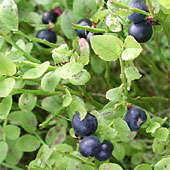Bilberry
Keywords: bilberry, European blueberry, whortleberry, huckleberry, night vision

© Dr. Peter J. Llewellyn
On this page:
- Introduction
- What It Is Used For
- How It Is Used
- What the Science Says
- Side Effects and Cautions
- Sources
- For More Information
Introduction
This fact sheet provides basic information about bilberry—common names, uses, potential side effects, and resources for more information. Bilberry is a relative of the blueberry, and its fruit is commonly used to make pies and jams. It has been used for nearly 1,000 years in traditional European medicine. Bilberry grows in North America, Europe, and northern Asia.
Common Names—bilberry, European blueberry, whortleberry, huckleberry
Latin Names—Vaccinium myrtillus
What It Is Used For
- Historically, bilberry fruit was used to treat diarrhea, scurvy, and other conditions.
- Today, the fruit is used to treat diarrhea, menstrual cramps, eye problems, varicose veins, venous insufficiency (a condition in which the veins do not efficiently return blood from the legs to the heart), and other circulatory problems.
- Bilberry leaf is used for entirely different conditions, including diabetes.
How It Is Used
The fruit of the bilberry plant can be eaten or made into extracts. Similarly, the leaves of the bilberry plant can be made into extracts or used to make teas.
What the Science Says
- Some claim that bilberry fruit improves night vision, but clinical studies have not shown this to be true.
- There is not enough scientific evidence to support the use of bilberry fruit or leaf for any health conditions.
Side Effects and Cautions
- Bilberry fruit is considered safe. However, high doses of bilberry leaf or leaf extract are considered unsafe due to possible toxic side effects.
- Tell your health care providers about any complementary and alternative practices you use. Give them a full picture of what you do to manage your health. This will help ensure coordinated and safe care.
Sources
- Bilberry. Natural Medicines Comprehensive Database Web site. Accessed July 2, 2007.
- Bilberry (Vaccinium myrtillus). Natural Standard Database Web site. Accessed June 28, 2007.
- Bilberry fruit. In: Blumenthal M, Goldberg A, Brinckman J, eds. Herbal Medicine: Expanded Commission E Monographs. Newton, MA: Lippincott Williams & Wilkins; 2000:16–21.
For More Information
- What's in the Bottle? An Introduction to Dietary Supplements
- Herbal Supplements: Consider Safety, Too
NCCAM Clearinghouse
The NCCAM Clearinghouse provides information on CAM and NCCAM, including publications and searches of Federal databases of scientific and medical literature. The Clearinghouse does not provide medical advice, treatment recommendations, or referrals to practitioners.
Toll-free in the U.S.: 1-888-644-6226
TTY (for deaf and hard-of-hearing callers): 1-866-464-3615
Web site: nccam.nih.gov
E-mail:
CAM on PubMed
Web site: nccam.nih.gov/camonpubmed/
NIH Office of Dietary Supplements
Web site: ods.od.nih.gov
NIH National Library of Medicine's MedlinePlus
Bilberry Listing: www.nlm.nih.gov/medlineplus/druginfo/natural/patient-bilberry.html
This publication is not copyrighted and is in the public domain. Duplication is encouraged.
NCCAM Publication No. D312
Created May 2006
Updated April 2008
Note: PDF files requires a viewer such as the free Adobe Reader.
